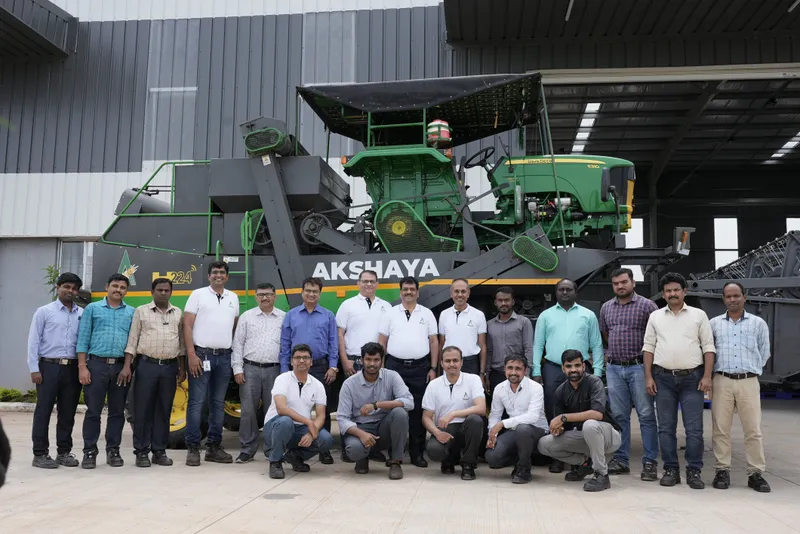This Pune-based startup wants to solve complex barriers in farming via tech
Founded in 2020, Akshaya Agri provides agricultural equipment, implements, and services space to small farmers. It has reached over one lakh farmers with its services.
India is still playing catch-up when it comes to mechanising agriculture. To remove traditional barriers via tech, was founded by Satish Nadiger, Abhijit Varade, Robesh Maity, Nilesh Pathak, and Amit Talwar in 2020.
According to the founders, only up to 55% of agriculture is mechanised in India versus globally where nearly all the processes are handled by tech.
"The space for farm machinery, beyond tractors, is majorly coming from unorganised sectors, which lack these characteristics and act as barriers for organised sectors," says Satish Nadiger, CEO and Director, Akshaya Agri.
This Pune-based startup provides mechanisation solutions and services in the non-tractor area to the agriculture sector. Agriculture is a lucrative domain for businesses to emerge. According to data from research organisation Imarc, the Indian agriculture equipment market was worth Rs. 926 billion in 2021 and is expected to reach Rs. 1,689 billion by 2027, at a CAGR of 10.6%.
The founders have worked together for more than 14 years during their stint with John Deere. The way Satish tells it, the genesis for Akshaya Agri came about when he was still in the industry. He found himself in a discussion about the second green revolution.
“In the first green revolution, India doubled production of food grains and became self-reliant, but the farmers' income levels did not improve significantly, and they were very unevenly distributed. He appealed that in the second green revolution, we must ensure farmers get a fair share of improvement. Hence, Akshaya Agri was formed on the mantra of Annadata Sukhibhava” he adds. Annadata Sukhi Bhava, a Sanskrit phrase, translates to "The provider of food must lead a bountiful living."
Akshaya Agri was founded with an equity investment of Rs 18 crore from personal and associates. At present, it has 35 employees, across engineering, supply management, operations, sales and marketing, finance, and other departments.
Deep dealer networks
Akshaya Agri’s vision to disrupt agriculture through tech is carried out through both the B2B and B2C routes. Fundamentally, it works on creating a dealer network that sustains the company’s operations. It does not directly provide services.
"These dealers and their teams are trained on each piece of equipment that we intend to launch into the market as a part of our go-to-market strategy,” says Satish. Further, these dealers are also responsible for after-sales support, which includes installation, customer support, and parts support throughout the lifecycle of equipment.
Each dealer works with a certain number of farmers. Farmers buy Akshaya Agri Machinery from the dealers. Presently, Akshaya Agri has a network of 17 dealers and is looking to onboard 16 more by October.
One-stop solution
Akshaya Agri has solutions that cater to all aspects of farming ranging from land preparation all the way to harvest. Its portfolio includes three products—NETRAA, AKSHAYA combines, and the VAJRAA brand of agricultural mechanisation equipment.
NETRAA is a connectivity device where customers can manage different activities of the tractor and harvester from a mobile application. It comes with a three-year subscription. According to Akshaya Agri, around 30 tractors are running on NETRAA services. It will add another 2,000 tractors in the next 10 months.
As for land preparation, this is where VAJRAA comes in. VAJRAA comes with a plough, a rotary tiller, and a cultivator. It helps a farmer to achieve mechanised farming.
For the harvest stage, Akshaya Agri has recently introduced the AKSHAYA Combine Harvester. A combination of lending farming solutions as a service and subscription models is how the firm makes money.
The cost of VAJRAA ranges between Rs 50,000 and 1 lakh, while harvesters cost between Rs 12 and 13 lakh. NETRAA is priced between Rs 13,000 and 15,000 to the end customer, also its B2C business arm. Akshaya Agri claims to have sold over 100 units of VAJRAA and 90 units of NETRAA to dealers.
Thus far, the company says it has reached over one lakh farmers with its services. It has also clocked in Rs 1 crore in sales via B2B sales in the latest fiscal year.

Akshaya Agri Team
Akshaya Agri has also established an R&D centre in Toopran, near Hyderabad, with an investment of Rs. 8.10 crore and has also invested Rs. 2.95 crore for product development. This has helped them bring down the cost and time of developing large equipment to less than a year.
Road ahead
For the next 4 years, the startup will focus on markets in Telangana, Andhra Pradesh, Tamil Nadu, Karnataka,
and Maharashtra. It is currently appointing dealers and distributors in these states.
The hiring cost of equipment varies across states and also for different equipment. It depends a lot on local practices, the season, the type of equipment, and fuel charges. In order to reduce its reliance on other sources for manufacturing, the firm will look to set up its own manufacturing unit in the next 18 months.
As for expanding its existing portfolio of agricultural solutions, in the short term, it will add a baler, post harvesting equipment to help farmers collect straws and pack them into bundles to be transported, as well as planter services, for seeding. Besides this, it is also looking to add drones into the mix. These drones will be used to help digitally map out fields and identify areas that require more attention.
(This copy has been updated to correct factual errors.)
Edited by Akanksha Sarma




![[Funding alert] Biotech startup Immuneel Therapeutics raises $15M in Series A round](https://images.yourstory.com/cs/5/f02aced0d86311e98e0865c1f0fe59a2/gene-editing-1640798908761.png?mode=crop&crop=faces&ar=1%3A1&format=auto&w=1920&q=75)


